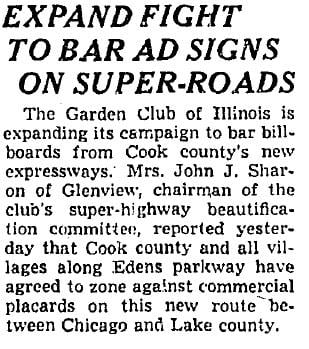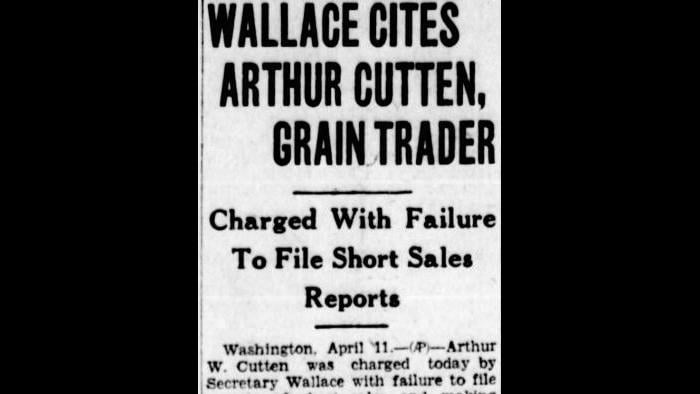Drivers along interstates like the Stevenson and the Jane Addams tollway are bombarded with billboards, while one expressway remains an ad-free paradise. (You might even call it an Eden.)
So how did the expressway through the North Shore suburbs get so lucky? Geoffrey Baer drives by with the answer to that and other viewer questions in this edition of Ask Geoffrey.
![]()

How does the Edens expressway stay free of billboards?
—Geoffrey Baer, WTTW
I’ve often wondered why there is a dense forest of billboards along so many Chicago area interstates, like the Jane Addams out beyond O’Hare, the Stevenson, Dan Ryan and so forth – and virtually no billboards on the Edens Expressway.
The short answer is that there is a state law prohibiting erection of billboards except in business and industrial areas. The law is called the Highway Advertising Control Act of 1971. Most of the Edens passes through residential areas and forest preserves where billboards are not permitted, but even in commercial areas of those communities, local zoning regulations forbid billboards.
The battle against billboards goes back to the early days of auto travel with organizations like the Garden Club of America at the vanguard. The foot soldiers in the fight were women.
Way back in 1933 the Chicago Tribune carried an article about a national meeting of the Garden Club at Chicago’s Drake Hotel at which state delegations reported on progress combatting “the billboard nuisance and disfigurement of the natural beauty” – by tearing down advertising signs and passing new restrictions.
 Two decades later in 1952, the chairwoman of the Garden Club of Illinois’ super-highway beautification committee reported that “Cook county and all villages along the Edens parkway had agreed to zone against commercial placards on this new route between Chicago and Lake County.”
Two decades later in 1952, the chairwoman of the Garden Club of Illinois’ super-highway beautification committee reported that “Cook county and all villages along the Edens parkway had agreed to zone against commercial placards on this new route between Chicago and Lake County.”
The club also hoped communities along what are now the Stevenson and Tri-State would pass similar restrictions, but as anyone who travels those highways can attest, they did not have the same success.
The 1971 state law was not so one-sided in its view of billboards. It sought to protect the beauty of the expressways, but also acknowledged the legitimate need of businesses to advertise. Since much of the land along Chicago’s other expressways is zoned as “business,” billboards are permitted.
![]()

As a volunteer at the Downers Grove Museum, I came across a 1980s photo of Du Page County workers moving a statue, one of two, from the Cutten House to the Hidden Lake Forest Preserve in Downers Grove and then to Danada Forest Preserve in Wheaton. Later, they were moved back to the Board of Exchange Building where they started and where they are today. Who was Mr. Cutten and how did he happen to have the statues in the first place?
—Carol Wandschneider, Downers Grove
You’d think it’d be hard to lose track of a couple of five-ton statues, but it happened! As our viewer said, the two 12-foot-tall granite goddess figures representing industry and agriculture now reside in a plaza near the Board of Trade. Their sculptor and country of origin are unknown, but we do know that they originally guarded the entrance of the first Board of Trade building, which was built in 1885.
That building was designed by W.W. Boyington, who also designed the Water Tower. It had the tallest clock tower in Chicago, but it was so shoddily constructed that the tower was torn down after 10 years, and the whole building was demolished in 1929. It was replaced with the Holabird and Root Art Deco tower that stands there today.
 Arthur Cutten
At the time, there wasn’t much of a sentiment for preservation or salvage, but Arthur Cutten, a wealthy grain trader known as the “Corn King” was an exception. According to a 1928 Chicago Tribune article, Cutten asked to have a few elements from the building saved for him as mementos of the old board.
Arthur Cutten
At the time, there wasn’t much of a sentiment for preservation or salvage, but Arthur Cutten, a wealthy grain trader known as the “Corn King” was an exception. According to a 1928 Chicago Tribune article, Cutten asked to have a few elements from the building saved for him as mementos of the old board.
He had two stained glass windows from the building and the two large statues, representing labor and commerce, brought to his country home, Sunny Acres Farm, in Downers Grove. They remained there until Cutten died in 1936 and his widow sold the property. That owner went on to sell the property as well.
After the DuPage Forest Preserve acquired the home and land in 1978, the statues were found half-buried in a grassy area. They were dug up from the land, which by then had become Hidden Lake Forest Preserve, and moved to Danada Forest Preserve in Wheaton.
When the Board of Trade learned of their rediscovery, the Forest Preserve voted to return the statues to CBOT, who placed them in the plaza just east of the Board of Trade in 2004.
Arthur Cutten himself also had an interesting history. He moved to Chicago as a 20-year-old from Ontario. After some time working odd jobs, he landed a job with a trading firm as a clerk, and then moved up to pit broker, and eventually struck out on his own.
He developed a reputation as a risk-taker who rode out the wild swings of the market to make millions – enough, obviously, to build his country home.

Nine men invaded that country home in 1922, robbing the Cuttens of jewels, cash, and more. The bandits then locked Cutten, his wife, his brother, a butler, and a mid in an airtight vault and left them there to suffocate to death. But the butler, John Johnson, used a small steel ruler to jimmy open the combination lock.
After they escaped, Cutten vowed to find the nine men. According to breathless newspaper accounts, he hired hundreds of private investigators and offered cash rewards to the police to track the men down. Seven of the nine bandits were apprehended within a few months, but it took eight years of relentless searching to track down the ringleader. Although Cutten continued his search, we could find no record of the last man ever being found.
Not long before his death, Cutten ran afoul of the law himself. He was the target of two federal investigations for market price manipulations and tax evasion. He escaped the charges of price manipulations, but he died of a heart attack before the tax evasion case could be tried. By then, his fortune had been decimated by the Great Depression – he went from a $100 million at his peak to just $350,000 at the time of his death. His remaining estate was on the hook for taxes, which is why his widow wound up selling the Sunny Acres property.
![]()
More Ask Geoffrey:
 Did you know that you can dig through our Ask Geoffrey archives? Revisit your favorite episodes, discover new secrets about the city’s past, and ask Geoffrey your own questions for possible exploration in upcoming episodes. Find it all right here.
Did you know that you can dig through our Ask Geoffrey archives? Revisit your favorite episodes, discover new secrets about the city’s past, and ask Geoffrey your own questions for possible exploration in upcoming episodes. Find it all right here.
Do you have a question for Geoffrey? Ask him.












